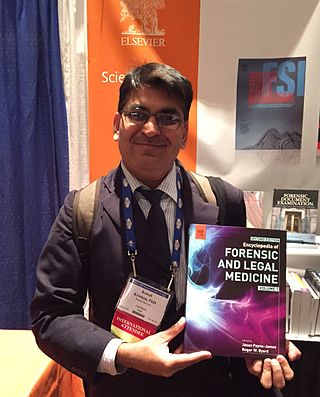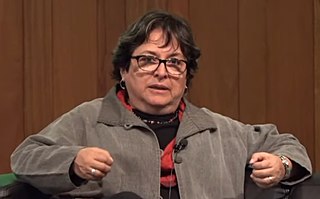Related Research Articles
Race is a categorization of humans based on shared physical or social qualities into groups generally viewed as distinct within a given society. The term came into common usage during the 16th century, when it was used to refer to groups of various kinds, including those characterized by close kinship relations. By the 17th century, the term began to refer to physical (phenotypical) traits, and then later to national affiliations. Modern science regards race as a social construct, an identity which is assigned based on rules made by society. While partly based on physical similarities within groups, race does not have an inherent physical or biological meaning. The concept of race is foundational to racism, the belief that humans can be divided based on the superiority of one race over another.

An anthropologist is a person engaged in the practice of anthropology. Anthropology is the study of aspects of humans within past and present societies. Social anthropology, cultural anthropology and philosophical anthropology study the norms, values, and general behavior of societies. Linguistic anthropology studies how language affects social life, while economic anthropology studies human economic behavior. Biological (physical), forensic and medical anthropology study the biological development of humans, the application of biological anthropology in a legal setting and the study of diseases and their impacts on humans over time, respectively.

Forensic anthropology is the application of the anatomical science of anthropology and its various subfields, including forensic archaeology and forensic taphonomy, in a legal setting. A forensic anthropologist can assist in the identification of deceased individuals whose remains are decomposed, burned, mutilated or otherwise unrecognizable, as might happen in a plane crash. Forensic anthropologists are also instrumental in the investigation and documentation of genocide and mass graves. Along with forensic pathologists, forensic dentists, and homicide investigators, forensic anthropologists commonly testify in court as expert witnesses. Using physical markers present on a skeleton, a forensic anthropologist can potentially determine a person's age, sex, stature, and race. In addition to identifying physical characteristics of the individual, forensic anthropologists can use skeletal abnormalities to potentially determine cause of death, past trauma such as broken bones or medical procedures, as well as diseases such as bone cancer.
A body farm is a research facility where decomposition of humans and animals can be studied in a variety of settings. The initial facility was conceived by anthropologist William M. Bass in 1981 at the University of Tennessee in Knoxville, Tennessee, where Bass was interested in studying the decomposition of a human corpse from the time of death to the time of decay. The aim was to gain a better understanding of the decomposition process, permitting the development of techniques for extracting information such as the timing and circumstances of death from human remains. Body farm research is of particular interest in forensic anthropology and related disciplines, and has applications in the fields of law enforcement and forensic science. By placing the bodies outside to face the elements, researchers are able to get a better understanding of the decomposition process.

Dr. Kathleen Joan Reichs (PhD) is an American crime writer, forensic anthropologist and academic. She is a professor emerita of anthropology at the University of North Carolina at Charlotte. She is well known for inspiring the television series Bones.

Forensic facial reconstruction is the process of recreating the face of an individual from their skeletal remains through an amalgamation of artistry, anthropology, osteology, and anatomy. It is easily the most subjective—as well as one of the most controversial—techniques in the field of forensic anthropology. Despite this controversy, facial reconstruction has proved successful frequently enough that research and methodological developments continue to be advanced.
Alison Galloway is a forensic anthropologist at the University of California, Santa Cruz. She is best known for her work in identifying the physical remains of Laci Peterson in the Scott Peterson Trial. She co-edited a book called The Evolving Female: A Life History Perspective with Mary Morbeck and Adrienne Zihlmann. She is also editor of "Broken Bones: Anthropological Analysis of Blunt Force Trauma" and co-editor of the second edition of that volume. She is also co-author of "Practicing Forensic Anthropology: an eResource" with Susan Kuzminsky.
Mongoloid is an obsolete racial grouping of various peoples indigenous to large parts of Asia, the Americas, and some regions in Europe and Oceania. The term is derived from a now-disproven theory of biological race. In the past, other terms such as "Mongolian race", "yellow", "Asiatic" and "Oriental" have been used as synonyms.

Harry Thomas Edwards is an American jurist. He served as a United States circuit judge of the United States Court of Appeals for the District of Columbia Circuit from 1980 to 2005, taking senior status in 2005, and a professor of law at the New York University School of Law.

Alan H. Goodman is a biological anthropologist and author. He served as president of the American Anthropological Association from 2005 to 2007. With Yolanda Moses, he co-directs the American Anthropological Association's Public Education Project on Race. His teaching, research and writing focuses on understanding how poverty, inequality and racism “get under the skin.” He received his PhD from the University of Massachusetts Amherst. Goodman was a pre-doctoral research fellow in stress physiology at the Karolinska Institute, Stockholm and a postdoctoral fellow in international nutrition at the University of Connecticut and the Salvador Zubirán National Institute of Health Sciences and Nutrition, Mexico.
Jeffrey E. Cole is an American anthropologist. He is professor of Anthropology, chairman of the Department of Anthropology and dean at Connecticut College, and served as president of the Society for the Anthropology of Europe of the American Anthropological Association from 2012 to 2014. Cole is an expert on race and ethnicity in Europe, a subject on which he has written and edited numerous books and articles.
Richard L. Jantz is an American anthropologist. He served as the director of the University of Tennessee Anthropological Research Facility from 1998–2011 and he is the current Professor Emeritus of the Department of Anthropology at the University of Tennessee, Knoxville. His research focuses primarily on forensic anthropology, skeletal biology, dermatoglyphics, anthropometry, anthropological genetics, and human variation, as well as developing computerized databases in these areas which aid in anthropological research. The author of over a hundred journal articles and other publications, his research has helped lead and shape the field of physical and forensic anthropology for many years.

Hugh Berryman is a U.S. forensic anthropologist with areas of expertise in blunt force trauma, skeletal remains, and osteology. He is one of only three forensic anthropologists in the state of Tennessee and seventy-four in the nation certified by the American Board of Forensic Anthropology. Additionally, he has received two awards offered by the American Academy of Forensic Sciences (AAFS): the Ellis R. Kerley Award in 2008 and the T. Dale Stewart lifetime achievement award in 2012. Due to his areas of expertise and qualifications, his assistance has been sought by local, state, and federal authorities as well as private interests.
Alice Mossie Brues was a physical anthropologist.
Yolanda Theresa Moses is an anthropologist and college administrator who served as the 10th president of City College of New York (1993–1999) and president of the American Association for Higher Education (2000–2003).

Kewal Krishan, an Indian forensic anthropologist, is a professor of physical anthropology and former Chair of Department of Anthropology at Panjab University, Chandigarh, India. He has recently been appointed as Dean, International Students, Panjab University, Chandigarh, India. He has contributed to the development of forensic anthropology in India. He is one of the very few forensic anthropology experts of the nation.
Clark Spencer Larsen is an American biological anthropologist, author, and educator. His work focuses on bioarchaeology, the study of human remains from archaeological settings. Although his interests span the entire record of human evolution, his research largely pertains to the last 10,000 years, a period of dynamic change in health, well-being, and lifestyle, much of which relates to population increase, overcrowding, and nutritional decline that co-occurred with the transition from hunting and gathering to agriculture, creating living conditions that humans are grappling with to the present day.

Sonia Elizabeth Guillén is a Peruvian anthropologist and the President of the Centro Mallqui, who is the current Minister of Culture of Peru. She was elected a foreign associate the National Academy of Sciences (NAS) in 2012.
Mary Huffman Manhein is an American forensic anthropologist. Nicknamed The Bone Lady, she was the founding director of the Forensic Anthropology and Computer Enhancement Services (FACES) laboratory at Louisiana State University (LSU) in 1990, and of the Louisiana Repository for Unidentified and Missing Persons Information Program in 2006. The repository is considered the "most comprehensive statewide database of its kind".
References
- 1 2 "Faculty/Staff". Forensic Biology Department. Michigan State University. Retrieved 12 July 2016.
- ↑ Verria, Lawrence (2012). The Kissing Sailor: The Mystery Behind the Photo That Ended World War II. Naval Institute Press. p. 173. ISBN 9781612511276.
- 1 2 "Faculty". Department of Anthropology website. Michigan State University. 2 November 2011. Retrieved 12 July 2016.
- ↑ "Dr. Norman J. Sauer Named Vice President of the American Academy of Forensic Sciences". Michigan State University. 30 September 2015. Retrieved 12 July 2016.
- ↑ Walker, Andrea K. (11 November 2011). "Stolen mummy to return home to UM medical school". Baltimore Sun. Retrieved 12 July 2016.
- ↑ Owens, David (9 November 2012). "Sailor In Iconic VJ Day Photo Is Rhode Island Man". Hartford Courant. Retrieved 12 July 2016.
- ↑ Href, Mailto; Lawson, Willow. "Anthropologists Disagree About Race and Bones". ABC News. Retrieved 12 July 2016.